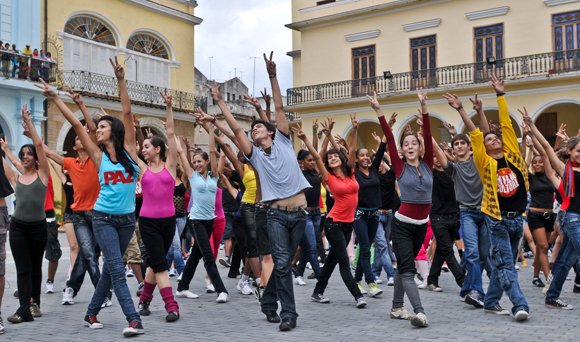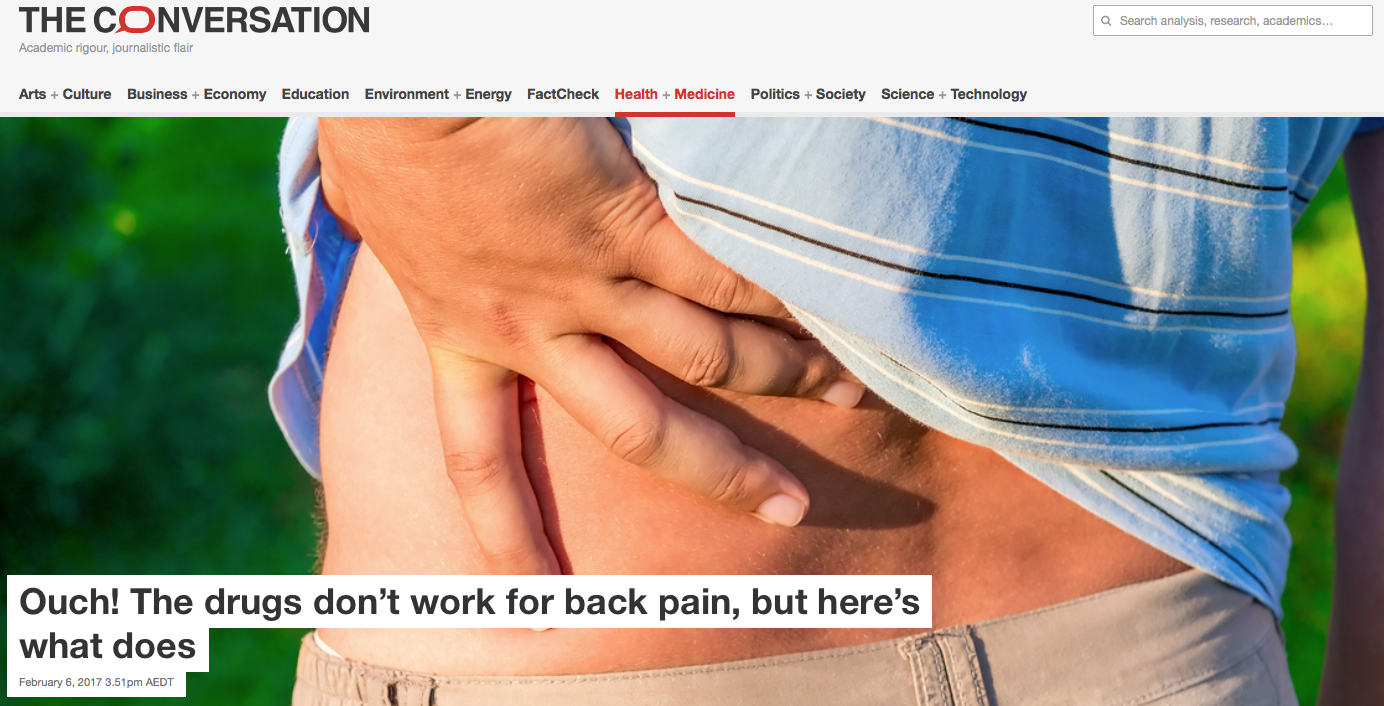
My usual morning routine includes a scan of various media to check if anything blog-worthy has popped up – social media, RSS feeds and email subscriptions provide a rich (often overabundant) field to harvest from. The Health + Medicine section of The Conversation is a favourite, not necessarily for its quality or accuracy – although there is a high frequency of both good quality and accurate reporting – but because it provides a glimpse into public discourse in two important ways. Firstly, the articles provide a sense of what the public is being told; often by experts attempting to translate research findings into everyday language (Lorimer Moseley has appeared on a number of occasions). Secondly, the comments section offers some insight into how the message was received, while furnishing the intrepid reader with a reasonably unfiltered exposé of societal beliefs on a topic (albeit from a self-selected population).
A recent piece – with a snappy headline combining a song title from one of the all time finest bands and the words ‘back pain’ was certainly going to be a blip on my radar:
Ouch! The drugs don’t work for back pain, but here’s what does
… But treating it [back pain] seems very difficult. Backing up a 2015 study showing paracetamol is ineffective for back pain, our latest research shows non-steroidal anti-inflammatory drugs (NSAIDs), such as Nurofen and Voltaren, provide minimal benefits and high risk of side effects.
Opioids such as oxycodone should also be avoided for back pain, since they have shown to increase the chances of having serious side effects, including misuse, overdose and dependency. In Australia, about 20% of people who see a GP for back pain are prescribed an opioid painkiller, but recent research has shown it provides minimal benefit for people with back pain.
Other treatments and activities that don’t help
Bed rest is not helpful for back pain… Other treatment options – including acupuncture, ultrasound, electrical nerve simulation, and corsets or foot orthotics – are not recommended, since there is no strong evidence supporting their use.
Even if the cause of back pain is unknown, imaging (x-rays, MRI) is unlikely to influence management or provide meaningful information.
Help, I’ve got back pain!
…Second, once people have back pain, they should be given tailored advice and information to help them self-manage their condition. Patients should be reminded of the benign nature of back pain. Most of us will have some pain in our lower back but very rare cases will be associated with more serious causes (cancer, fracture). Reminding people of the importance of keeping active within their own limitations is also crucial. This includes going for a short walk or avoiding prolonged sitting.
Further, people with back pain should consider physiotherapy treatments and engage in exercise programs, including aerobic exercises, strengthening, stretching, Pilates or yoga. These interventions have small but proven efficacy in relieving back pain symptoms with small or no side effects.
In all, not a bad PSA – simple analgesics are a waste of time, NSAIDs aren’t much better and carry a risk of nasty unwanted effects; avoid opioids, unnecessary investigations, and passive treatments; understanding the problem and being reassured that nothing serious is happening in the vast majority of cases is good; and keep active – although it probably doesn’t matter what you do, as long as you do something, generally sums it up.
A strong passing grade.
What did the mob think

So far, 25 comments, and a mixed bag:
Shane wasn’t impressed with the medical professions ability to diagnose his long term back pain, but he did find a low hourly rate professional(?) who provided a cohesive, logically plausible (to Shane), mechanistically orientated diagnosis that seemed to resonate:
“Up until recently I have had severe and debilitating back pain for 40 years and have been through most if not all of the so called treatment. The main problem was a lack of diagnosis – nobody in the medical profession knew how to diagnose the problem. It took a $30 an hour masseuse who showed me that the tendons in my lower back on the right hand side had been torn and that had made my lower spine unstable. Hence, when nerves were hit ouch. Chiropractors helped get things off the nerve and now after all this time I think the lower discs have fused together so it is much better. As for the medical profession – months of physio and ultra sound treatment (useless), myelogram (useless), CT scans and MRI (useless, but showed inflamed discs, but no treatment. I already knew the discs were inflamed from the pain so what was the point?)”
Richard’s comment hinted at a level of higher education and a healthy scepticism
“…The link you provide to the evidence for this “small but proven efficacy” for these currently fashionable activities [physiotherapy, exercises, Pilates, yoga] takes one to a Cochrane review of Multidisciplinary Biopsychosocial Rehabilitation – hardly appropriate evidence for recommending any of these individual “treatments”. Have you any gold-standard evidence to recommend any of these therapies (eg placebo-controlled) or are your treatment recommendations no more sound than the common recommendations for paracetamol or NSAIDS have been?”
Mark reported that all night, steady up and down movement was the key to fixing his low back pain
“My long-standing back pain vanished 25 years ago after I moved to a waterbed. I can’t say that will work for everyone; but if you sleep on your back then the steady up and down movement all night long (because as you breathe in and out your boyancy changes slightly) will flex your spine in ways that ought to be good for it.”
Rob wasn’t convinced, but was reasonable enough
“Hi, this article reads like it has been written in broad brush strokes by somebody who has never had back pain. I’ve always found that when I have the occasional episode of pain due to my old disc injury flaring up, taking pain killers for a few days is a good way to help break the cycle of muscular tension while I work carefully at my tried and true exercises to relieve the attendant muscle spasm.”
Louis was all-in on hanging by the ankles
Have you ever tried a back-swing? It is a type of see-saw where you hang by your ankles to align your spine and neck. There is no doubt is can help with some back problems. I have never been to a chiropractor since buying one 30 years ago. It is available 24/7 in the shed and costs nothing after the initial purchase.
Tim was sad that osteopathy was omitted
“A great article , but alas sadly Osteopathic treatment is not mentioned…”
And Ben, ‘didn’t want to’ (but did anyway?) start a conversation about chiropractic being overlooked
“I don’t want to start a big ‘it works for me’ versus ‘it’s all rubbish like homeopathy’ comment thread here, but the one word missing in this piece is ‘chiropractic’.”
But Steve wasn’t being fooled
“Great article. Some people seem to be bemoaning that Chiro or Osteopathy is not mentioned. Why? They’re pretty much useless for back and neck issues and can be quite damaging. Weight reduction, rest, sensible exercise, avoiding movements that cause stress on the back, good posture, a good bed, not sitting for too long, etc all good. Chiro ‘adjustments’ not good, but will adjust your wallet.”
Jean’s advice showed that age was no barrier to activity
“I was born with a deformity at L5 and am 91. My best aid is a good heat pad one on my rocking chair (easy to get out of) and one by my bed. I use them all the time. I do gardening on hands and knees and this gives me flexibility as I twist around looking for my tools”
And John (perhaps of a vintage in the same ball park as Jean) similarly kept it real, and kept it simple
“As a previous sufferer of back pain, I found a 30 minute walk everyday and regular exercise including lightweight lifting and bike riding, cured me.”
The people have spoken

A rather polite mob, not unruly at all, and on the balance, not too bad – while there are likely some strongly held misconceptions, the overall premise of the piece seems to have been accepted and there is a good number of simple, non-catastrophic attitudes towards low back pain, along with some healthy scepticism of the medicalisation (and commercialisation) of low back pain.
Maybe efforts at disseminating simple, accurate, up to date information about back pain is working? Reason for hope perhaps.
-Tim Cocks

Adelaide, 26-28 May EP + GMI
Wollongong, 14-16 July EP + GMI
Darwin, 4-6 August EP + GMI
Brisbane, 25-27 August EP + GMI
Newcastle, 8-10 September EP + GMI


Tim, I do much the same thing at some ungodly hour of the morning. But I found the “Conversation” article you mention, plus the responses, quite predictable and somewhat boring.
Now if you are looking for more lively responses, why not try this one that appeared yesterday?: http://www.doctorportal.com.au/mjainsight/2017/4/nothing-traditional-about-acupuncture/?email=jqu33431@bigpond.net.au&lid=601105&utm_source=MJA+InSight&utm_campaign=7e68213019-hidden-risks-of-herbals-%7C-timely-pap-fo_2017-02-09&utm_medium=email&utm_term=0_7346f35e23-7e68213019-42092493
Hi John
In this instance, a little bit of predictability, even banality, might not be such a bad thing perhaps??
Thanks for the link to Dr Ieraci’s post, an interesting take on TCM and its not so ancient wisdom. But given the topic, I reckon I could have predicted the responses (and the emotion) with good precision!! All the old chestnuts are there – “I’ve got more papers than you”, “Who cares if there are no meridians, it just works”, “They were doing this in BC – BC ok!!!”, “You clearly don’t understand the nuances of ‘true’ TCM or acupuncture” and of course the sneaky Ad Hom “Were you time poor… (with the implied “…or are you just stupid”)”
Dr Ieraci does seem to be very optimistic though when she asks
“So, my question is this: is acupuncture the last bastion of acceptable placebo use in Australian medicine?”
As you suggest – TCM acupuncture is far from the last bastion that needs assaulting.
Best
Tim
And in the US of A, the TCM acupuncturists are vigorously defending their turf against the onslaught of the PT “dry needlers”. The comments are quite interesting from either side. Incidentally, Geoff Bove and I have added our few cents worth: http://www.townhall.virginia.gov/L/Comments.cfm?StageID=7570
Nice article Tim. Maybe it’s time to shift our focus away from educating the practitioner to educating the general public 😉